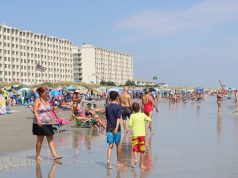
By DONALD WITTKOWSKI
His critics were hardly diplomatic in their feelings about Mayor William Haffert’s refusal to rezone the primary gateway into Sea Isle City for residential housing in the 1940s and ’50s.
“Haffert’s Folly” was the label they saddled him with in their anger. They wanted housing construction for all of the tax ratables it would have generated for the town. But Haffert said no.
The passage of time now shows that Haffert’s decision all those years ago was visionary. Everyone who enters Sea Isle on what is now called the John F. Kennedy Boulevard Bridge can see it for themselves – a broad, inviting and attractive entryway considered one of the most scenic views of any barrier island at the Jersey Shore.
“He was a remarkable person in so many ways. He was a forward-thinking person,” recalled Haffert’s grandson, Pat Haffert, 75, a longtime Sea Isle resident.
Sea Isle has now formally recognized Haffert’s foresight and his courage to stand up to his critics with the unveiling of a historical plaque that stands at the entryway to the city at JFK Boulevard and Park Road.
About 30 members of the Haffert family joined with Mayor Leonard Desiderio and other city officials for the unveiling ceremony Saturday next to the Sea Isle City Welcome Center.
The family members included Haffert’s grandchildren, great-grandchildren and great-great-grandchild. Pat Haffert was joined by fellow grandchildren Nancy Bogda, 83, Mark Haffert, 73, and Jan Craine, 72. The other surviving grandchild, Elisabeth Haffert, 76, did not attend the ceremony.
“I was obviously proud. He was very well-respected in the community,” Pat Haffert said about the new plaque honoring his grandfather.

William Anthony Haffert Sr. served as Sea Isle mayor from 1945 to 1956. A native of Elizabeth, N.J., he developed an interest in urban planning that carried over when he moved to Sea Isle. Among his accomplishments, he founded the Sea Isle City and Cape May County planning boards to oversee development.
“He was a big believer in urban planning,” Pat Haffert said in an interview Monday.
He was also well-known in Sea Isle as the owner of Garden State Publishing Co., the publisher of farming, agricultural and gardening magazines.
Decades ago, Sea Isle was served by a roadway informally named “Railroad Boulevard. It was the entryway for former train service to the resort town.
At the end of the railroad era, Haffert envisioned a new gateway into town in place of Railroad Boulevard. To help make it happen, he steadfastly refused to rezone the same area for housing construction – a decision that directly pitted him against the city officials who wanted residential construction for the tax ratables it would have created. They, in turn, responded with the “Haffert’s Folly” insult.
Haffert, though, stood his ground. The “Haffert’s Folly” epithet stuck with him until the monstrous storm of 1962 destroyed much of Sea Isle and what followed was the construction of the now-JFK Boulevard Bridge as the new entryway into town.
“Mayor Haffert’s foresight and perseverance graced Sea Isle with ‘JFK Boulevard,’ one of the broadest, most scenic gateways onto any barrier island on the Jersey Shore. His vision is now our view,” the plaque reads.
The assassination of President John F. Kennedy on Nov. 22, 1963, just weeks after the new bridge was opened, prompted Sea Isle to name its newly created entryway into town as “JFK Boulevard.”

Prior to JFK’s assassination, a petition was circulated to name the new bridge “Haffert Boulevard” in honor of his grandfather, Pat Haffert said.
Even some of Mayor Haffert’s critics had begun to recognize the wisdom of protecting Sea Isle’s main entryway from housing development in those days, Haffert added.
However, Mayor Haffert admitted that the “worst thing” he did while he was in office involved another push for housing development and tax ratables, Haffert said.
The mayor allowed for the removal of sand from the dunes to be used as fill for a housing development that stretched from Landis and Pleasure avenues between 61st Street and about 68th Street.
It was a decision Haffert always regretted, because by stripping the sand off the dunes, it reduced Sea Isle’s natural layer of protection against coastal storms, his grandson said.
William Haffert died in 1976, 20 years after leaving the mayor’s office. Looking back, Pat Haffert said his grandfather’s style as a politician was more as a consensus-builder than a “my-way-or-the-highway type of person.”
Except, apparently, for his dogged refusal to rezone Sea Isle’s now-broad and inviting entryway for housing construction in the 1940s and ’50s.







